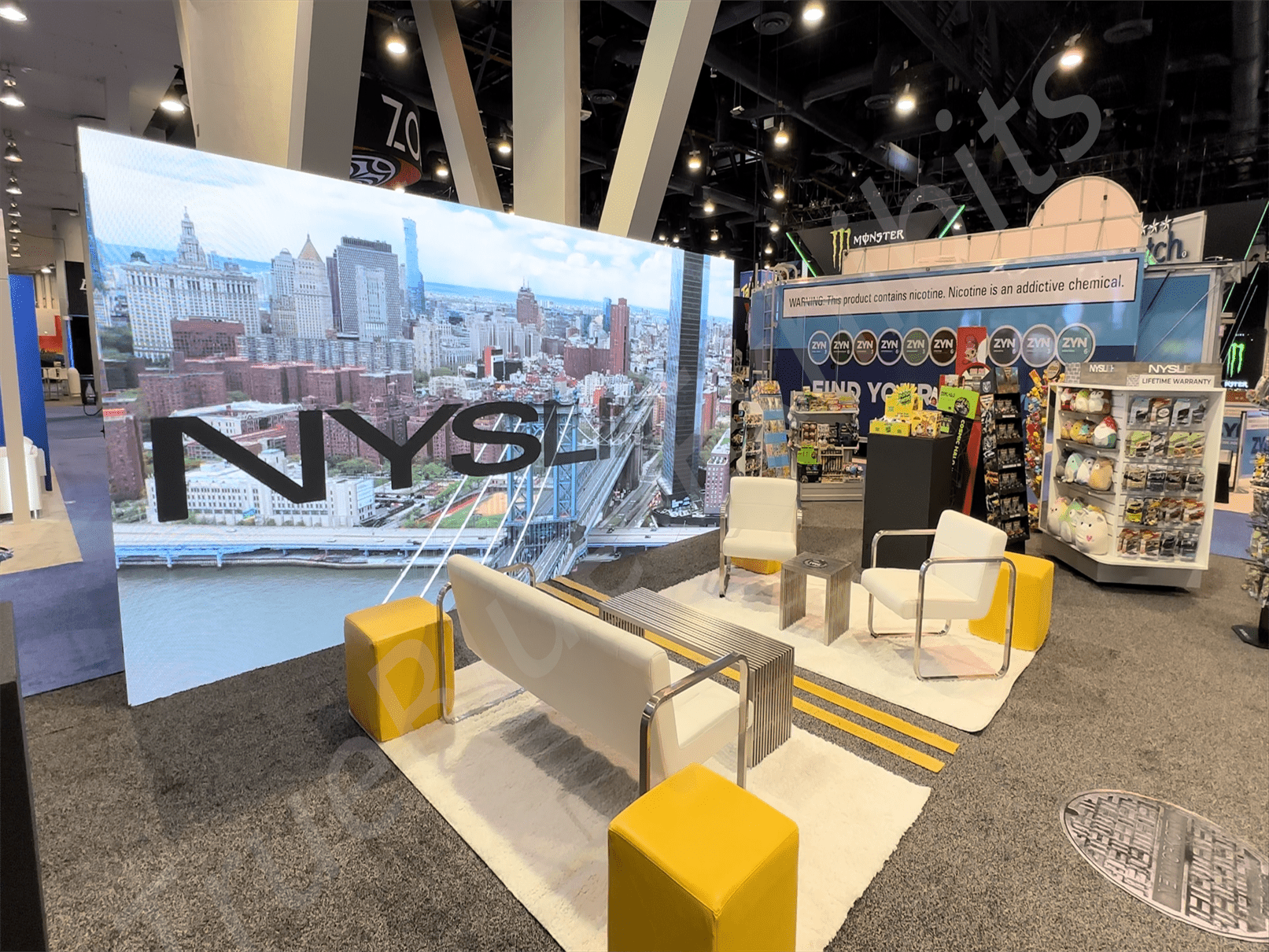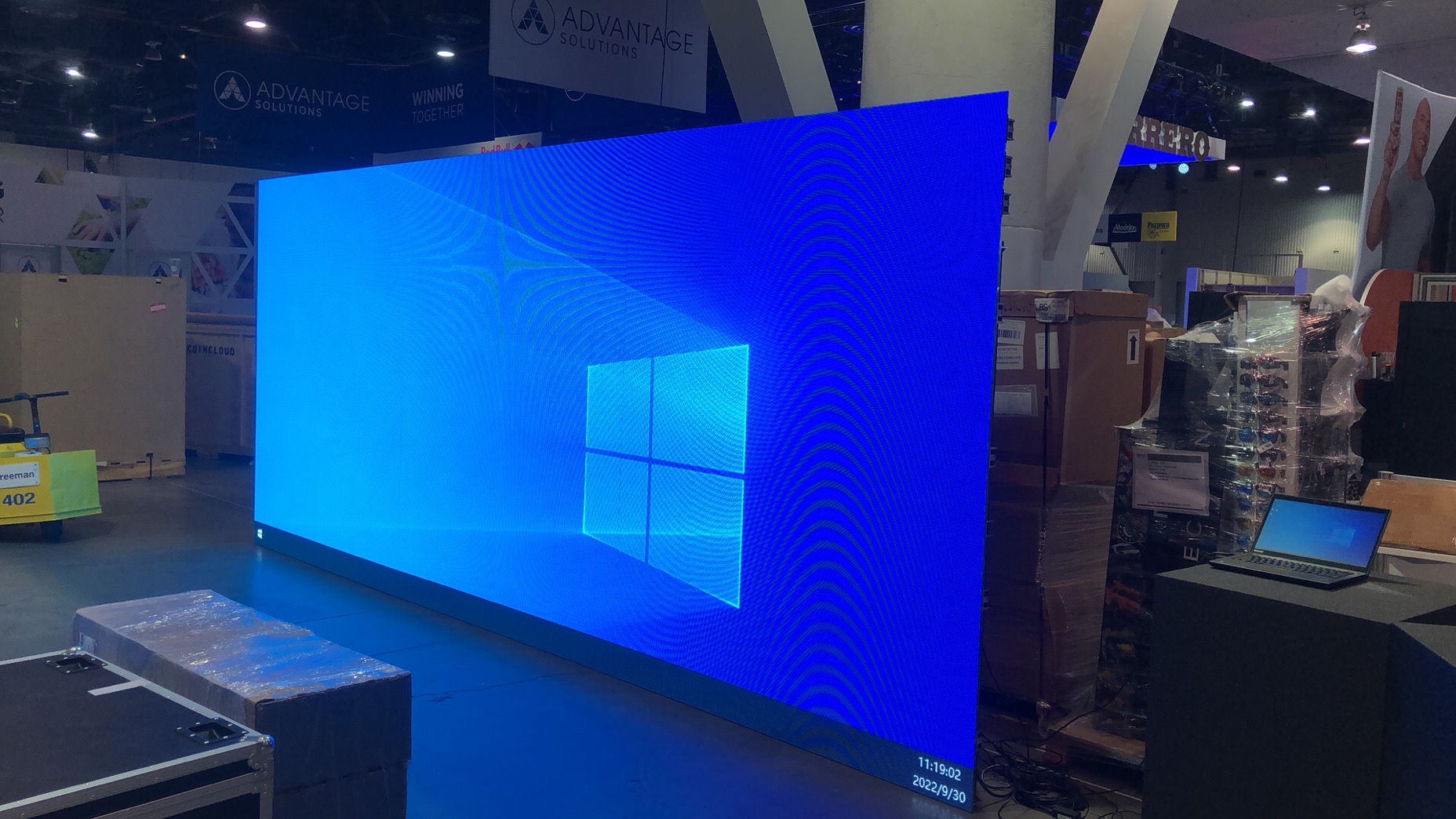Table of Contents
I want to add a large-scale video wall to my next exhibit, but I’m wondering which medium to use: LED panels/curtains, projection technology, or an array of seamless monitors. What are the pros and cons of each?
Answer
When it comes to these three multimedia options, your decision will likely hinge on myriad factors, including the amount of ambient light in the environment, resolution required, available space within the exhibit, ease of installation, and budget allotted. To help you better understand how each of these variables applies to each medium – and to ultimately decide which one is right for you – here’s a brief overview of the three multimedia options along with some general cost and application advice.
Convention centers are usually filled with ambient light, which means that the brighter your video wall, the more it will stand out. In terms of brightness, then, LED panels win hands down over other mediums given the inherent intensity of the technology. Plus, LED panels take up minimal space in the exhibit and during transport, as they are flat and compact.
However, LEDs typically can’t compete with seamless monitors when it comes to resolution. Every increment of increased resolution will cost you. That’s because LEDs are categorized by pixel pitch (among other things), which is basically the distance from the center of one pixel cluster to another. The smaller the pixel pitch, the greater the resolution. But the smaller you go, the more you’ll pay per panel. For example, a 3-by-3-foot LED wall with a pixel pitch of 6 mm will cost almost twice as much as a 12 mm wall with the same dimensions.
As a side note related to size and pixel pitch, if an exhibit employs massive LED curtains or scenic LED panels (some of the largest of which can reach 24,000 square feet). They’re almost always used for creating atmosphere or adding eye candy, not displaying detailed video or text. To create an LED wall of this size and scale with a high resolution pixel pitch that supports video and text would be cost prohibitive to most exhibitors.

Source: https://trueblue-exhibits.com/led-video-wall-portfolio/nyslife-nacs-show-p3-9-20ft-x-8ft-led-video-wall-rental-new-led-panel-inventory/
Another drawback of LEDs also happens to be one of its benefits, i.e., its brightness. If attendees are in close proximity to the panel, the degree of brightness can easily be off-putting. And finally, while all three options will usually require a significant number of labor hours to set up and possibly suspend them from truss, LED panels are generally the most labor intensive due to the amount of assembly required, and as such will usually ring up a larger labor bill.
While projection technologies come up short in terms of brightness, they generally offer better resolution than LEDs at the same price point. For example, a 10-by-10-foot LED panel that costs $30,000 will have a much lower resolution than projected content of the same dimensions and cost.
Plus, a projector sends a single image with consistent colors to the screen. With a group of seamless monitors, each monitor is only displaying a portion of the image or content, and colors between monitors may not match. (See more on color matching in the next section.) When it comes to shipping and drayage, projection technology is usually the cheapest of the three options, as you’re typically just shipping a couple of rectangular projectors and a single lightweight screen, as opposed to an entire wall of technology that breaks down into many components.
The main drawback of projection technology is that reflective surfaces and ambient light – elements that are found in almost every single convention center’s exhibit hall. It can wreak havoc on the image quality. Granted, some of these issues can be controlled by using a high-gain screen. Moreover, by carefully locating the projection and screen components within the exhibit environment for optimal light and glare control. Still, you’re never going to get the same high-quality level of brightness as you would with an LED panel.
In addition, projection technology requires a throw distance and screen. A projector must be placed somewhere within the confines of your exhibit (unless you receive a variance from show management to mount it outside your booth space), and the screen must be located a considerable distance away from it, depending on the specific projector. Exhibitors often employ lightweight fabric scrim as a screen, or they project onto existing support structures such as exterior walls. Thus, as mentioned earlier, your shipping and drayage rates for these components may be less than those of other multimedia options. Plus, projectors are usually easier to set up than LEDs and seamless monitors. However, projection technology will take up more space within an exhibit than other multimedia options on the table.

Source: https://trueblue-exhibits.com/led-video-wall-portfolio/nyslife-nacs-show-p3-9-20ft-x-8ft-led-video-wall-rental-new-led-panel-inventory/
When it comes to resolution, seamless monitors are king, making them the perfect delivery medium for detailed images, text, video, etc. Plus, they’re generally flat and compact. This makes them fairly easy to ship and the least cumbersome of all multimedia options to set up. And compared to projectors, they require less space in a booth.
However, seamless monitor arrays are only slightly better than projection technology in terms of brightness. They can have some issues with regards to color matching. When you arrange multiple monitors together and then display a single image across them, you should synchronize all monitors. You should make sure that forest green on screen one looks exactly the same as forest green on screen eight. Your audiovisual provider should set up color matching ahead of time, before shipping to the show floor.
But if not properly matched, seamless monitors can require considerable time on the show floor for the technician to properly program each monitor. In addition, you need to take special care when creating the content. You need to ensure that it fits properly across the monitor configuration you have planned.
As you can see, there are multiple variables to consider when choosing between these three multimedia options. But to help you better understand how they all stack up to each other. Consider this simplistic breakdown, which ranks the three multimedia options against one another. (One is the best or most beneficial, and three is the least advantageous.)
Brightness 1; Resolution to Cost Ratio 3; Minimal Exhibit Space Required 1; Ease of Installation 3
Brightness 3; Resolution to Cost Ratio 1; Minimal Exhibit Space Required 3; Ease of Installation 1
Brightness 2; Resolution to Cost Ratio 2; Minimal Exhibit Space Required 2; Ease of Installation 2
Of course, price is also a definite consideration. However, prices vary greatly, depending on resolution and dimensions. But to give you a ballpark estimate, here is a breakdown for a 9-by-16-foot display. In this scenario, a 3 mm LED wall could cost as much as $35,000. Meanwhile, seamless monitors would run you approximately $20,000, and projection would likely top out at about $10,000.
Clearly, then, no one technology is consistently and overtly better than the other. But by considering the aforementioned information and your own resolution, size, installation, and cost parameters, you can easily identify the solution that’s best for your booth.
 We Do It Right, The First Time and Every Time
We Do It Right, The First Time and Every Time
 3D Booth Rendering
3D Booth Rendering Always Go
Always Go Win-Win Happy
Win-Win Happy Everything
Everything  Committed
Committed  Customer
Customer Clockwork
Clockwork